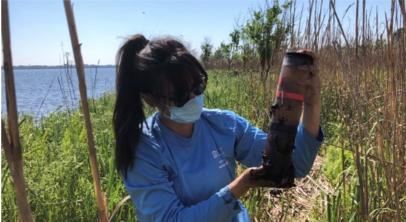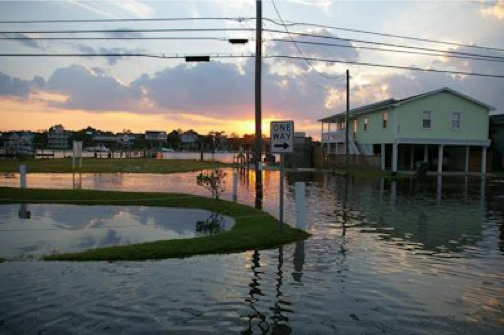Anne Smiley is a doctoral student with the UNC Institute of Marine Sciences in the Piehler lab. Her research focuses on ecosystem functions and coastal habitat.
Growing up on the coast
 Growing up in the panhandle of Florida, coastal ecosystems served as the backdrop for most of my childhood. I was always fascinated by the dynamic nature of the coastal landscape—the shifting barrier islands and the senescence of seagrasses. While the scenery of my hometown is unmatched, its location on the northern coast of the Gulf of Mexico made it prone to hurricanes. Evacuations and post-storm clean-ups are also vivid memories. These experiences undoubtedly shaped my research interests today, which focuses on distributions of coastal habitat and ecosystem functions.
Growing up in the panhandle of Florida, coastal ecosystems served as the backdrop for most of my childhood. I was always fascinated by the dynamic nature of the coastal landscape—the shifting barrier islands and the senescence of seagrasses. While the scenery of my hometown is unmatched, its location on the northern coast of the Gulf of Mexico made it prone to hurricanes. Evacuations and post-storm clean-ups are also vivid memories. These experiences undoubtedly shaped my research interests today, which focuses on distributions of coastal habitat and ecosystem functions.
Ecosystem function and resilience
Coastal habitats naturally perform a myriad of functions that support and protect coastal communities. For example, habitats can diffuse wave energy, stabilize sediments, and cycle nutrients. These functions contribute to coastal resilience by reducing the negative impacts of major storms and floods, such as infrastructural damage, land loss, and water quality degradation. I am investigating the degree to which human activity affects proper ecosystem functioning during ambient fair-weather conditions, as well as ecosystem response during and after major storms.
Nitrogen and water quality
 My research involves fieldwork and laboratory experiments to measure how well different coastal habitats regulate water quality through the removal of nitrogen. Nitrogen removal is an essential function, as excess concentrations disrupt aquatic ecosystems by fueling nuisance algal blooms that deplete oxygen and degrade habitat. My research also involves coupling these experimental measurements with publicly available spatial datasets to construct habitat maps and calculate nitrogen removal potential at the landscape scale.
My research involves fieldwork and laboratory experiments to measure how well different coastal habitats regulate water quality through the removal of nitrogen. Nitrogen removal is an essential function, as excess concentrations disrupt aquatic ecosystems by fueling nuisance algal blooms that deplete oxygen and degrade habitat. My research also involves coupling these experimental measurements with publicly available spatial datasets to construct habitat maps and calculate nitrogen removal potential at the landscape scale.
 Floodwaters act as a vehicle to transport substantial amounts of nitrogen into nutrient-sensitive systems, thus, hurricanes are often punctuated with diminished water quality. Human activity can exacerbate this effect by simultaneously increasing nutrient pollution and reducing the nitrogen removal capacity of the natural landscape. Nitrogen-based fertilizers run off of agricultural landscapes, wastewater effluent flows out of discharge pipes, and stormwater delivers municipal and household products to nearby waterways. This type of chronic nutrient addition may act to erode a coastal system’s overall resilience—its capacity to respond during and after a major storm. Along with altered functioning, outright loss of ecosystems and their associated functions are often consequences of development. As coastal populations continue to grow, it is imperative that we preserve these ecosystems to not only maintain ecological integrity, but also to maximize coastal resilience for these growing communities.
Floodwaters act as a vehicle to transport substantial amounts of nitrogen into nutrient-sensitive systems, thus, hurricanes are often punctuated with diminished water quality. Human activity can exacerbate this effect by simultaneously increasing nutrient pollution and reducing the nitrogen removal capacity of the natural landscape. Nitrogen-based fertilizers run off of agricultural landscapes, wastewater effluent flows out of discharge pipes, and stormwater delivers municipal and household products to nearby waterways. This type of chronic nutrient addition may act to erode a coastal system’s overall resilience—its capacity to respond during and after a major storm. Along with altered functioning, outright loss of ecosystems and their associated functions are often consequences of development. As coastal populations continue to grow, it is imperative that we preserve these ecosystems to not only maintain ecological integrity, but also to maximize coastal resilience for these growing communities.
A changing landscape in a changing climate
 This work has important applications along rapidly developing coastlines that are also experiencing the effects of climate change. In the last 26 years alone, North Carlina has experienced three hurricanes that caused floods exceeding North Carolina’s 100-year floodplain, signifying a significant increase in storm activity. Coupled with rising sea levels, there is increased exposure to storm- and flood-associated hazards, including water quality degradation. My research will help to inform coastal management strategies to assess and incorporate nature-based solutions to improve coastal resilience.
This work has important applications along rapidly developing coastlines that are also experiencing the effects of climate change. In the last 26 years alone, North Carlina has experienced three hurricanes that caused floods exceeding North Carolina’s 100-year floodplain, signifying a significant increase in storm activity. Coupled with rising sea levels, there is increased exposure to storm- and flood-associated hazards, including water quality degradation. My research will help to inform coastal management strategies to assess and incorporate nature-based solutions to improve coastal resilience.


